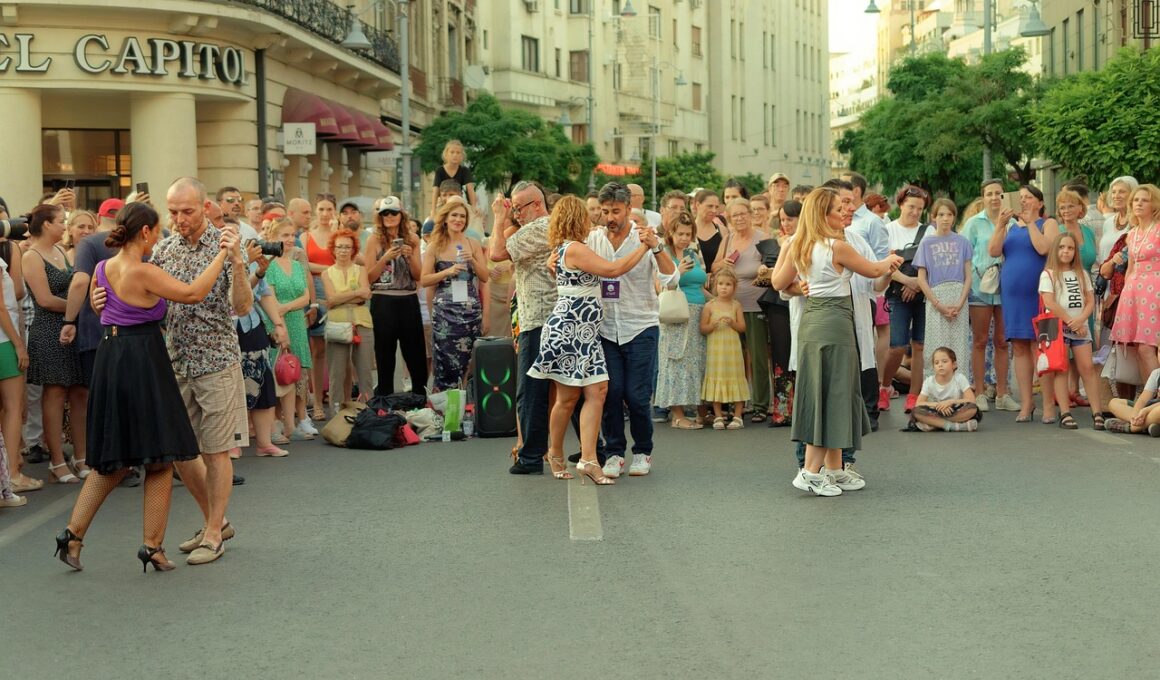The Business Side of Dance Fitness Competitions
In recent years, dance fitness competitions have surged in popularity, combining artistry and physical prowess. This trend has created substantial opportunities for entrepreneurs looking to tap into this vibrant market. To establish a successful business in this field, one must consider marketing strategies that appeal to participants and audiences alike. Digital marketing plays a crucial role here, allowing businesses to reach wider audiences through social media platforms. Engaging content, such as videos showcasing routines and highlighting the benefits of dance fitness classes, can significantly amplify your reach. Additionally, offering early-bird registration discounts has proven effective in attracting participants. Dance fitness competitions often rely on sponsors to offset costs, so cultivating partnerships with local businesses can enhance your event’s financial viability. Furthermore, an engaging website is essential, serving as a hub for information. Timely updates about registration and event details can help maintain interest. Working with fitness-related influencers can also promote your competition, bringing in a demographic that values both fitness and fun. When executed well, these strategies can transform a dance fitness event into a thriving business opportunity.
Understanding the Target Audience
Identifying and understanding your target audience is crucial for success in dance fitness competitions. Participants can range from amateur dancers eager to showcase their skills to seasoned professionals seeking competitive exposure. Knowing what resonates with these groups informs promotional strategies and event planning. For example, younger audiences may prefer vibrant, high-energy music, while older participants might appreciate varied programming focused on fun and fitness without intense competition. Surveying previous competitors can provide valuable insights into their preferences, allowing for tailored experiences that foster greater participation. Hosting focus groups can also encourage community involvement and investment in the competition. Building an engaging community around your event ensures loyalty, persuading competitors to return annually. Furthermore, incorporating technology, such as mobile apps, can facilitate real-time feedback and interaction, enriching the participant experience. Social media engagement offers platforms for community building and fostering relationships. Utilize hashtags specific to your event to help cultivate these online communities. Ultimately, understanding your target audience allows for tailored marketing, enhances participant experiences, and encourages repeat attendance at your dance fitness competitions.
The logistics of organizing dance fitness competitions are complex and multifaceted, requiring careful planning and execution. Venues play a significant role, with considerations around location, size, and amenities that suit different participant needs. Assessing potential venues should look for accessibility, parking options, and proximity to public transportation, ensuring a seamless experience for participants. Additionally, investing in proper sound and lighting equipment can elevate the professional quality of the competition, attracting both competitors and spectators. Event scheduling must balance competitive performance times with audience engagement through workshops or demonstrations. Staff management is critical, as trained personnel can contribute significantly to the event’s success. Volunteer recruitment can help alleviate costs while creating a sense of community. Also, considering insurance and liability aspects is vital; security measures should be in place to protect participants and spectators. Establishing a clear timeline for planning activities is essential, with deadlines for key milestones like registration, marketing, and coordination with media partners. This approach not only streamlines logistics but also enhances overall event efficiency, ensuring a professional atmosphere that encourages participation and supports future growth.
Sponsorship and Partnerships
Attracting sponsors is crucial for enhancing the financial backing of dance fitness competitions. Potential sponsors can include local gyms, health food brands, and wellness centers that target similar demographics. Crafting a compelling sponsorship proposal that outlines mutual benefits, including brand visibility and audience engagement opportunities, is essential. Highlighting the potential for lead generation and community goodwill can build interest among sponsors eager for increased exposure. Prepare to offer various sponsorship levels, from presenting sponsors to smaller contributions, each with distinct benefits. Involve sponsors in promotional activities, such as featuring their logos in marketing materials and on stage during events. Building partnerships is an ongoing effort that requires relationship maintenance even after events are over. A follow-up with sponsors post-event can demonstrate appreciation and lay the groundwork for future collaborations. Networking with local businesses can also generate promotional opportunities, including discounts for event participants at their establishments. Such alliances reinforce community connections and improve perceived value, fostering a supportive environment for future competitions that benefit both organizers and local businesses alike.
Marketing strategies play a significant role in the realm of dance fitness competitions. A solid marketing campaign not only boosts participation but also increases audience engagement. Utilizing digital marketing techniques, such as email campaigns and social media promotions, can effectively reach potential participants. Engaging content including fitness tips and highlights from previous competitions can stimulate community interest. Influencer partnerships help to leverage niche audiences, showcasing the excitement of the event. Creating professional and eye-catching promotional materials can further enhance visibility. Moreover, integrating contests and giveaways encourages potential participants to share the event with their networks. Utilizing targeted Facebook and Instagram ads can increase reach by focusing on specific demographics that value dance and fitness experiences. Local news outlets and fitness publications can also be approached for coverage, bolstering visibility among interested audiences. Networking with fitness trainers or dance schools to promote the event is effective as well. Consider hosting pre-event workshops, allowing participants to hone their skills while promoting the upcoming competition. A combination of engaging content and targeted marketing strategies can make dance fitness competitions much more appealing, leading to greater success and participation in the industry.
Event Day Execution
The execution of dance fitness competitions on the event day is paramount to its overall success. A well-organized schedule ensures that everything runs smoothly, making for an enjoyable experience for all. Arriving at the venue early allows for adequate setup time, making adjustments if necessary based on logistical conditions. Staff should be briefed thoroughly to ensure they understand their roles, from registration to assistance during performances. Creating a checklist can help the team stay organized and focused on key responsibilities throughout the day. Establishing a communication system, such as walkie-talkies or mobile apps, ensures that updates can be shared promptly. Providing participants with clear guidelines, including schedules and rules, enhances their experience. It’s essential to execute technical rehearsals to address any potential issues with sound, lighting, or performance areas before the competition begins. Audience engagement during the event can boost excitement; including interactive segments, such as audience voting or Q&A sessions with judges, creates additional interest. Closing the event with an award ceremony can enhance the experience for competitors, recognizing their hard work while encouraging community involvement and future participation.
Post-event evaluations are crucial for the continuous improvement of dance fitness competitions. Collecting feedback from participants, organizers, and staff can provide invaluable insights into the event’s strengths and weaknesses. Surveys can be distributed immediately following the event to capture attendees’ experiences while the memories are fresh. Analyzing this feedback enables organizers to implement enhancements for future events, creating exciting improvements predicated on actual participant desires. Additionally, maintaining relationships with sponsors and partners post-event is essential. Following up with sponsors to convey appreciation and share event highlights allows for building long-lasting business relationships. Providing sponsors with data, such as attendance figures and participant demographics, supports discussions for future collaborations. Celebrating successes within the organizing team fosters morale and commitment to future events. Sharing photos and videos from the event on social media can keep the community engaged while building excitement for next year’s competitions. Moreover, documenting lessons learned systematically can enhance the strategic planning process, preparing organizers for even greater success in upcoming events. Ultimately, ongoing evaluation is vital to staying relevant and continuing to evolve the business side of dance fitness competitions.
Conclusion: The Future of Dance Fitness Competitions
The future of dance fitness competitions appears promising, with ongoing trends indicating continued growth. The increasing awareness of health and wellness encourages more individuals to participate in dance fitness. Moreover, integrating technology, such as virtual competitions or streaming events, expands reach and inclusivity. This shift opens doors for participants who may not easily access traditional competitions due to geographical or financial constraints. Events can benefit from enhanced audience engagement through innovative virtual options, reaching a global audience. Reflecting on planning and marketing strategies employed sets the stage for future success, emphasizing the importance of adaptability. Emerging trends can be quickly incorporated into event structure, driving relevance and continued interest. Sustainability is also becoming a focal point, with organizers looking to implement eco-friendly practices, appealing to environmentally conscious audiences. As the ecosystem around dance fitness competitions evolves, it becomes crucial for organizers to stay ahead of industry changes. By fostering community ties and adjusting to participant needs, dance fitness can cement its place as an exciting competitive domain. Embracing these opportunities will ensure the vitality and prosperity of future dance fitness competitions.


